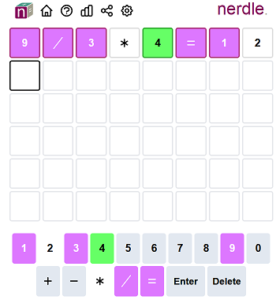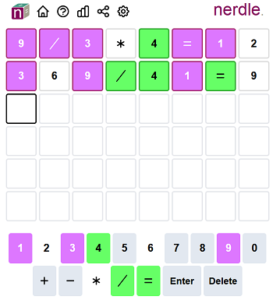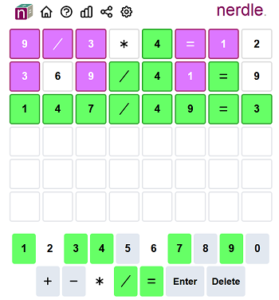The Nerdle logic game involves guessing an 8-symbol arithmetic equation, which uses only integers, an equal sign, and the four arithmetic operations. For instance, the equation might be 9 / 3 * 4 = 12. That was my first guess in the example below, which is from the puzzle posted at the gamesite on 01-Jan-2023:

The green colour of the digit “4” means that the solution contains “4” at that position. The purple colour of the digits “9”, “3”, “1”, the operator “/” and the equal sign “=” means that the solution contains those symbols but at some other positions. The white colour of the symbol “*” and the digit “2” means that the solution does not utilize those symbols.
Now one can make a second guess. It is time for some reasoning. Since the equal sign is not in position 6, it is likely in position 7, so hypothesize that position 8 is a single digit. The possibilities for position 8 are anything but “2”.
Let’s try putting the division operator in position 4, so that we will be dividing “1xx” or “3xx” or “4xx” by “4x” to get a single digit result, some result between 3 and 9. For instance, 9 times 43 equals 387. But that trial solution would not contain a “1”, so cannot be correct. Also not correct would be 9 times 40, 42, 44, 45, 46, 47, 48, 49 because such a solution would either contain a digit “2” or would be missing a digit “1” or “3”. However, we can try 9 times 41 which equals 369. So, our second guess will be 369 / 41 = 9. Here is the result:

We have some additional information. The solution does not contain a “6”. We know that the division operator is in position 4 and have confirmed that the equal sign is in position 7. As well, we know there is only one “9” digit in the solution, and have excluded “3” and “9” from being in certain positions.
Let’s continue with the hypothesis that the only operator in the solution is a single division. We will abandon that hypothesis if we cannot find a solution compatible with it. This means that we have a single digit value (not 2 or 9, and also not 1, hence something between 3 and 8) following the equal sign, and that value times “4x” must be “1xx”. So we can conclude the value following the equal sign is 3 or 4. Let’s check some possibilities. We can calculate the products of 3 or 4 times “4x”. There must be a “9” in either position 2 or position 6, and there can be only one “9” in the solution.
Considering the case of a “9” in position 6, we look at 3*49 = 147 (which is ok) and 4*49 = 196 (which is not ok, as there would be two “9” digits in the solution). This is enough to give us a third guess. We will not bother to consider possible solutions of the form “19x” divided by “4x” where the latter value is not 49. Here is the result from our third guess at a solution, 147 / 49 = 3:

And that is the solution to today’s Nerdle puzzle.
Some remarks: 1) This post will be scheduled to be posted at 2100 hours Eastern time today 01-Jan-2023, so that the solution to today’s Nerdle puzzle will not be a spoiler. The Nerdle website rolls over to a new puzzle at 0000 hours UTC daily, so by the time this post appears the current puzzle with be the 02-Jan-2023 puzzle. (All the times on my LASI site are Eastern North American time, aka “Toronto” time, which is UTC-5 time zone.)
2) The Nerdle website is at https://nerdlegame.com/
3) I usually run Nerdle with an ad-blocker. The site displays dynamically changing advertisements and that interferes with the pleasure of figuring out the puzzle.
4) My customary initial guess is 9/3*4=12. That gives a reasonable amount of information as it tests a string of digits (1,2,3,4) and two operators. That is not the optimal first guess, based upon some calculations done by a friend. But it is satisfactory for my enjoyment. There are undoubtedly other web resources which assist with analysis of Nerdle puzzles.
Happy puzzle solving, for a Happy New Year!
Best wishes, from Ken Roberts, 01-Jan-2023





